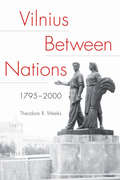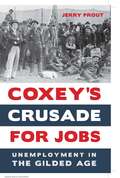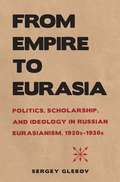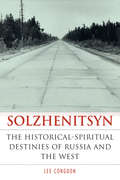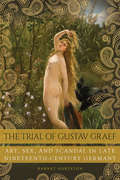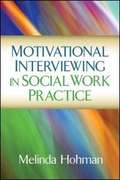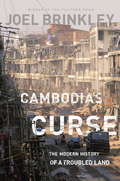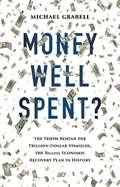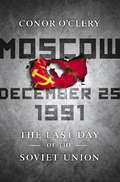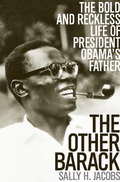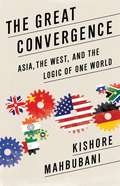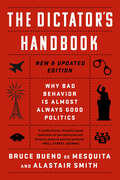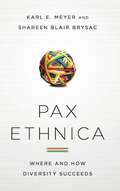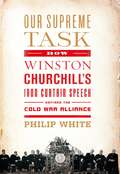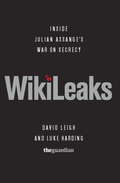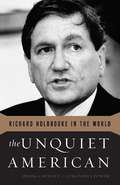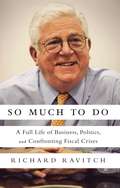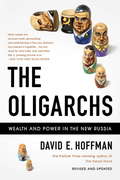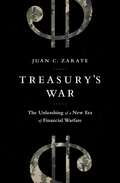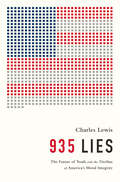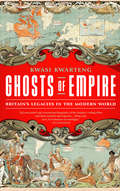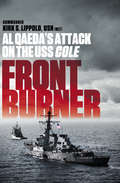- Table View
- List View
Vilnius between Nations, 1795–2000 (NIU Series in Slavic, East European, and Eurasian Studies)
by Theodore R. WeeksThe inhabitants of Vilnius, the present-day capital of Lithuania, have spoken various languages and professed different religions while living together in relative harmony over the years. The city has played a significant role in the history and development of at least three separate cultures—Polish, Lithuanian, and Jewish—and until very recently, no single cultural-linguistic group composed the clear majority of its population.Vilnius between Nations, 1795–2000 is the first study to undertake a balanced assessment of this particularly diverse city. Theodore Weeks examines Vilnius as a physical entity where people lived, worked, and died; as the object of rhetorical struggles between disparate cultures; and as a space where the state attempted to legitimize a specific version of cultural politics through street names, monuments, and urban planning. In investigating these aspects, Weeks avoids promoting any one national narrative of the history of the city, while acknowledging the importance of national cultures and their opposing myths of the city's identity. The story of Vilnius as a multicultural city and the negotiations that allowed several national groups to inhabit a single urban space can provide lessons that are easily applied to other diverse cities. This study will appeal to scholars of Eastern Europe, urban studies, and multiculturalism, as well as general readers interested in the region.
Coxey’s Crusade for Jobs: Unemployment in the Gilded Age
by Jerry ProutIn the depths of a depression in 1894, a highly successful Gilded Age businessman named Jacob Coxey led a group of jobless men on a march from his hometown of Massillon, Ohio, to the steps of the nation's Capitol. Though a financial panic and the resulting widespread business failures caused millions of Americans to be without work at the time, the word unemployment was rarely used and generally misunderstood. In an era that worshipped the self-reliant individual who triumphed in a laissez-faire market, the out-of-work "tramp" was disparaged as weak or flawed, and undeserving of assistance. Private charities were unable to meet the needs of the jobless, and only a few communities experimented with public works programs. Despite these limitations, Coxey conceived a plan to put millions back to work building a nationwide system of roads and drew attention to his idea with the march to Washington. In Coxey's Crusade for Jobs, Jerry Prout recounts Coxey's story and adds depth and context by focusing on the reporters who were embedded in the march. Their fascinating depictions of life on the road occupied the headlines and front pages of America's newspapers for more than a month, turning the spectacle into a serialized drama. These accounts humanized the idea of unemployment and helped Americans realize that in a new industrial economy, unemployment was not going away and the unemployed deserved attention. This unique study will appeal to scholars and students interested in the Gilded Age and US and labor history.
From Empire to Eurasia: Politics, Scholarship, and Ideology in Russian Eurasianism, 1920s–1930s (NIU Series in Slavic, East European, and Eurasian Studies)
by Sergey GlebovThe Eurasianist movement was launched in the 1920s by a group of young Russian émigrés who had recently emerged from years of fighting and destruction. Drawing on the cultural fermentation of Russian modernism in the arts and literature, as well as in politics and scholarship, the movement sought to reimagine the former imperial space in the wake of Europe's Great War. The Eurasianists argued that as an heir to the nomadic empires of the steppes, Russia should follow a non-European path of development. In the context of rising Nazi and Soviet powers, the Eurasianists rejected liberal democracy and sought alternatives to Communism and capitalism. Deeply connected to the Russian cultural and scholarly milieus, Eurasianism played a role in the articulation of the structuralist paradigm in interwar Europe. However, the movement was not as homogenous as its name may suggest. Its founders disagreed on a range of issues and argued bitterly about what weight should be accorded to one or another idea in their overall conception of Eurasia. In this first English language history of the Eurasianist movement based on extensive archival research, Sergey Glebov offers a historically grounded critique of the concept of Eurasia by interrogating the context in which it was first used to describe the former Russian Empire. This definitive study will appeal to students and scholars of Russian and European history and culture.
Solzhenitsyn: The Historical-Spiritual Destinies of Russia and the West (NIU Series in Slavic, East European, and Eurasian Studies)
by Lee CongdonIn this examination of Solzhenitsyn and his work, Lee Congdon explores the consequences of the atheistic socialism that drove the Russian revolutionary movement. Beginning with a description of the post-revolutionary Russia into which Solzhenitsyn was born, Congdon addresses the Bolshevik victory in the civil war, the origins of the concentration camp system, the Bolsheviks' war on Christianity and the Russian Orthodox Church, Solzhenitsyn's arrest near the war's end, his time in the labor camps, his struggle with cancer, his exile and increasing alienation from the Western way of life, and his return home. He concludes with a reminder of Solzhenitsyn's warning to the West—that it was on a path parallel to that which Russia had followed into the abyss.
The Trial of Gustav Graef: Art, Sex, and Scandal in Late Nineteenth-Century Germany
by Barnet HartstonAlthough largely forgotten now, the 1885 trial of German artist Gustav Graef was a seminal event for those who observed it. Graef, a celebrated sixty-four-year-old portraitist, was accused of perjury and sexual impropriety with underage models. On trial alongside him was one of his former models, the twenty-one-year-old Bertha Rother, who quickly became a central figure in the affair. As the case was being heard, images of Rother, including photographic reproductions of Graef's nude paintings of her, began to flood the art shops and bookstores of Berlin and spread across Europe. Spurred by this trade in images and by sensational coverage in the press, this former prostitute was transformed into an international sex symbol and a target of both public lust and scorn. Passionate discussions of the case echoed in the press for months, and the episode lasted in public memory for far longer. The Graef trial, however, was much more than a salacious story that served as public entertainment. The case inspired fierce political debates long after a verdict was delivered, including disputes about obscenity laws, the moral degeneracy of modern art and artists, the alleged pernicious effects of Jewish influence, legal restrictions on prostitution, the causes of urban criminality, the impact of sensationalized press coverage, and the requirements of bourgeois masculine honor. Above all, the case unleashed withering public criticism of a criminal justice system that many Germans agreed had become entirely dysfunctional. The story of the Graef trial offers a unique perspective on a German Empire that was at the height of its power, yet riven with deep political, social, and cultural divisions. This compelling study will appeal to historians and students of modern German and European history, as well as those interested in obscenity law and class and gender relations in nineteenth-century Europe.
Motivational Interviewing In Social Work Practice (PDF)
by Melinda HohmanMotivational interviewing (MI) offers powerful tools for helping social work clients draw on their strengths to make desired changes in their lives. This reader-friendly book introduces practitioners and students to MI and demonstrates how to integrate this evidence-based method into direct practice. Melinda Hohman and her associates describe innovative applications for diverse clients and practice areas, including substance abuse treatment, mental health, child welfare, community organizing, and others. Extensive sample dialogues illustrate MI skills in action with individuals and groups. The book also presents best practices for MI training, teaching, and agency-wide integration. This book is in the Applications of Motivational Interviewing series, edited by Stephen Rollnick, William R. Miller, and Theresa B. Moyers.
Cambodia's Curse: The Modern History of a Troubled Land
by Joel BrinkleyA Pulitzer Prize-winning journalist describes how Cambodia emerged from the harrowing years when a quarter of its population perished under the Khmer Rouge. A generation after genocide, Cambodia seemed on the surface to have overcome its history--the streets of Phnom Penh were paved; skyscrapers dotted the skyline. But under this façade lies a country still haunted by its years of terror. Although the international community tried to rebuild Cambodia and introduce democracy in the 1990s, in the country remained in the grip of a venal government. Pulitzer Prize-winning journalist Joel Brinkley learned that almost a half of Cambodianswho lived through the Khmer Rouge era suffered from P.T.S.D.--and had passed their trauma to the next generation. His extensive close-up reporting in Cambodia's Curse illuminates the country, its people, and the deep historical roots of its modern-day behavior.
Money Well Spent?: The Truth Behind the Trillion-Dollar Stimulus, the Biggest Economic Recovery Plan in History (Playaway Adult Nonfiction Ser.)
by Michael GrabellThe 2012 presidential campaign will, above all else, be a referendum on the Obama administration's handling of the financial crisis, recalling the period when Obama's "audacity of hope” met the austerity of reality. Central to this is the ''American Recovery and Reinvestment Act of 2009''-the largest economic recovery plan in American history. Senator Mitch McConnell gave a taste of the enormity of the money committed: if you had spent 1 million a day since Jesus was born, it still would not add up to the price tag of the stimulus package. A nearly entirely partisan piece of legislation- Democrats voted for it, Republicans against- the story of how the bill was passed and, more importantly, how the money was spent and to what effect, is known barely at all. Stepping outside the political fray, ProPublica's Michael Grabell offers a perceptive, balanced, and dramatic story of what happened to the tax payers' money, pursuing the big question through behind-the-scenes interviews and on-the-ground reporting in more than a dozen states across the country.
Moscow, December 25, 1991: The Last Day of the Soviet Union
by Conor O'CleryThe implosion of the Soviet Union was the culmination of a gripping game played out between two men who intensely disliked each other and had different concepts for the future. Mikhail Gorbachev, a sophisticated and urbane reformer, sought to modernize and preserve the USSR; Boris Yeltsin, a coarse and a hard drinking "bulldozer,” wished to destroy the union and create a capitalist Russia. The defeat of the August 1991 coup attempt, carried out by hardline communists, shook Gorbachev's authority and was a triumph for Yeltsin. But it took four months of intrigue and double-dealing before the Soviet Union collapsed and the day arrived when Yeltsin could hustle Gorbachev out of the Kremlin, and move in as ruler of Russia.Conor O'Clery has written a unique and truly suspenseful thriller of the day the Soviet Union died. The internal power plays, the shifting alliances, the betrayals, the mysterious three colonels carrying the briefcase with the nuclear codes, and the jockeying to exploit the future are worthy of John Le Carré or Alan Furst. The Cold War's last act was a magnificent dark drama played out in the shadows of the Kremlin.
The Other Barack: The Bold and Reckless Life of President Obama's Father
by Sally H. JacobsThe life story of the father of the most powerful elected leader in the world is an epic tale, one as daring as it was improbable.The father of the U.S. president, the first Barack Hussein Obama, was born in rural poverty in Kenya. His own father was a dominating figure who worked as a cook for the British colonists and broke with Luo tradition when he converted to the Muslim faith. Their household was a severe one from which Barack's mother fled in fear for her life. Despite such domestic turmoil, Barack was as fiercely smart as he was intrepid. Admitted to one of Kenya's premiere private schools, he was later thrown out for his defiant behavior.Adrift in the political churning of Kenya's pre-independence days, Barack attracted the interest of an American literacy worker who took him under her wing. By day, they worked on the literacy primers that would change the lives of illiterate Africans. By night, they often went dancing in the full glare of disapproval of those racially segregated times. She helped him prepare for college in America and in 1959 paid his first year's tuition at the University of Hawaii. The first African student on the UH campus, Barack stood out in many respects. One of those was the young white woman, Ann Dunham, whom he began to date. A year after they met, the couple had a son named Barack Hussein Obama II. Barack did not tell his young wife about the two children he had left behind in Kenya, nor did he tell university authorities about his family back home until much later. Luos were often polygamous and Obama saw no need to part with custom.At Harvard University, Barack joined the academic elite and prepared to take his place among the big men in newly independent Kenya. But Barack's experience at Harvard was emblematic of a life that seesawed between high hopes and cruel frustrations, many of them self-inflicted in drunken furies. Yet the charm, the intellectual brilliance, and the fierce pride in his vision of independent Kenya never flagged. He was a bold and reckless man, whose life courted controversy and ultimately veered fatally out of his control. He was heroic in his ambition, deeply flawed, and, extraordinarily, the father of an American president, the other Barack.
The Great Convergence: Asia, the West, and the Logic of One World
by Kishore MahbubaniThe twenty-first century has seen a rise in the global middle class that brings an unprecedented convergence of interests and perceptions, cultures and values. Kishore Mahbubani is optimistic. We are creating a new global civilization. Eighty-eight percent of the world's population outside the West is rising to Western living standards, and sharing Western aspirations. Yet Mahbubani, one of the most perceptive global commentators, also warns that a new global order needs new policies and attitudes.Policymakers all over the world must change their preconceptions and accept that we live in one world. National interests must be balanced with global interests. Power must be shared. The U.S. and Europe must cede some power. China and India, Africa and the Islamic world must be integrated. Mahbubani urges that only through these actions can we create a world that converges benignly. This timely book explains how to move forward and confront many pressing global challenges.
The Dictator's Handbook: Why Bad Behavior is Almost Always Good Politics
by Alastair Smith Bruce Bueno de MesquitaA groundbreaking new theory of the real rules of politics: leaders do whatever keeps them in power, regardless of the national interest.As featured on the viral video Rules for Rulers, which has been viewed over 3 million times.Bruce Bueno de Mesquita and Alastair Smith's canonical book on political science turned conventional wisdom on its head. They started from a single assertion: Leaders do whatever keeps them in power. They don't care about the "national interest"-or even their subjects-unless they have to. This clever and accessible book shows that democracy is essentially just a convenient fiction. Governments do not differ in kind but only in the number of essential supporters, or backs that need scratching. The size of this group determines almost everything about politics: what leaders can get away with, and the quality of life or misery under them. The picture the authors paint is not pretty. But it just may be the truth, which is a good starting point for anyone seeking to improve human governance.
Pax Ethnica: Where and How Diversity Succeeds
by Karl E. Meyer Shareen Blair BrysacIn a world replete with stories of sectarian violence, we are often left wondering: Are there places where people of different ethnicities, especially with significant Muslim minorities, live in peace? If so, why haven't we heard more about them, and what explains their success? To answer these questions, Karl Meyer and Shareen Brysac undertook a two-year exploration of oases of civility, places notable for minimal violence, rising life-expectancy, high literacy, and pragmatic compromises on cultural rights. They explored the Indian state of Kerala, the Russian republic of Tatarstan, the city of Marseille in France, the city of Flensburg, Germany, and the borough of Queens, New York. Through scores of interviews, they document ways and means that have proven successful in defusing ethnic tensions. This pathbreaking book elegantly blends political history, sociology, anthropology, and journalism, to provide big ideas for peace.
Our Supreme Task: How Winston Churchill's Iron Curtain Speech Defined the Cold War Alliance
by Philip WhiteThe year 1945 was a chaotic one, both for the world, of course, and for Winston Churchill. Communism was on the march and the people of Bulgaria, Romania, Yugoslavia, and Poland all found themselves in the grip of the Soviets. The Red Army occupied a large German territory, and the Kremlin was manipulating post-war food shortages, labor disputes, and social unrest in Greece, France, and Italy.Having spent his "wilderness years” in the late 1930s warning of the dangers of diplomatic and military weakness and the growing menace of Nazism, in 1946 Churchill made a trip to Fulton, Missouri, to deliver a speech entitled "The Sinews of Peace”-now known as the Iron Curtain Speech-which served to fundamentally define the dangers of Soviet totalitarian Communism. This is the story of that pivotal speech and how it came to be given, and a portrait of the irrepressible man who delivered it.
WikiLeaks: Inside Julian Assange's War on Secrecy
by David Leigh Luke HardingA team of journalists with unparalleled inside access provides the first full, in-depth account of WikiLeaks, its founder Julian Assange, and the ethical, legal, and political controversies it has both uncovered and provoked.
The Unquiet American: Richard Holbrooke in the World
by Samantha Power Derek CholletRichard Holbrooke, who died in December 2010, was a pivotal player in U.S. diplomacy for more than forty years. Most recently special envoy for Iraq and Afghanistan under President Obama, Holbrooke also served as assistant secretary of state for both Asia and Europe, and as ambassador to both Germany and the United Nations. He had a key role in brokering a peace agreement among warring factions in Bosnia that led to the Dayton Peace Accords in 1995.Widely regarded to possess one of the most penetrating minds of any modern diplomat of any nation, Holbrooke was also well known for his outsized personality, and his capacity to charm and offend in equally colossal measures. In this book, the friends and colleagues who knew him best survey his accomplishments as a diplomat, activist, and author. Excerpts from Holbrooke&’s own writings further illuminate each significant period of his career.The Unquiet American is both a tribute to an exceptional public servant and a backstage history of the last half-century of American foreign policy.
Lifeblood: How to Change the World One Dead Mosquito at a Time
by Alex PerryIn 2006, the Wall Street pioneer and philanthropist Ray Chambers flicked through some holiday snapshots taken by his friend, development economist Jeff Sachs, and remarked on the placid beauty of a group of sleeping Malawian children. "They're not sleeping,” Sachs told him. "They're in malarial comas. A few days later, they were all dead.” Chambers had long avoided the public eye, but this moment sparked his determination to coordinate an unprecedented, worldwide effort to eradicate a disease that has haunted humanity since before the advent of medicine. Award-winning journalist Alex Perry obtained unique access to Chambers, now the UN Special Envoy for Malaria. In this book, Perry weaves together science and history with on-the-ground reporting and a riveting exposé of the workings of humanitarian aid to document Chambers' campaign. By replacing traditional ideas of assistance with business acumen and hustle, Chambers saved millions of lives, and upturned current notions of aid, forging a new path not just for the developing world but for global business and philanthropy.
So Much to Do: A Full Life of Business, Politics, and Confronting Fiscal Crises
by Richard RavitchEvery city and every state needs a Richard Ravitch. In sixty years on the job, whether working in business or government, he was the man willing to tackle some of the most complex challenges facing New York. Trained as a lawyer, he worked briefly for the House of Representatives, then began his career in his family's construction business. He built high-profile projects like the Whitney Museum and Citicorp Center but his primary energy was devoted to building over 40,000 units of affordable housing including the first racially integrated apartment complex in Washington, D.C. He dealt with architects, engineers, lawyers, bureaucrats, politicians, union leaders, construction workers, bankers, and tenants-virtually all of the people who make cities and states work.It was no surprise that those endeavors ultimately led to a life of public service. In 1975, Ravitch was asked by then New York Governor Hugh Carey to arrange a rescue of the New York State Urban Development Corporation, a public entity that had issued bonds to finance over 30,000 affordable housing units but was on the verge of bankruptcy. That same year, Ravitch was at Carey's side when New York City's biggest banks said they would no longer underwrite its debt and he became instrumental to averting the city's bankruptcy.Throughout his career, Ravitch divided his time between public service and private enterprise. He was chairman of the Metropolitan Transportation Authority from 1979 to 1983 and is generally credited with rebuilding the system. He turned around the Bowery Savings Bank, chaired a commission that rewrote the Charter of the City of New York, served on two Presidential Commissions, and became chief labor negotiator for Major League Baseball.Then, in 2008, after Governor Eliot Spitzer resigned in a prostitution scandal and New York State was in a post-financial-crisis meltdown, Spitzer's successor, David Paterson, appointed Ravitch Lieutenant Governor and asked him to make recommendations regarding the state's budgeting plan. What Ravitch found was the result of not just the economic downturn but years of fiscal denial. And the closer he looked, the clearer it became that the same thing was happening in most states. Budgetary pressures from Medicaid, pension promises to public employees, and deceptive budgeting and borrowing practices are crippling our states' ability to do what only they can do-invest in the physical and human infrastructure the country needs to thrive. Making this case is Ravitch's current public endeavor and it deserves immediate attention from both public officials and private citizens.
So Much to Do: A Full Life of Business, Politics, and Confronting Fiscal Crises
by Richard RavitchEvery city and every state needs a Richard Ravitch. In sixty years on the job, whether working in business or government, he was the man willing to tackle some of the most complex challenges facing New York. Trained as a lawyer, he worked briefly for the House of Representatives, then began his career in his family's construction business. He built high-profile projects like the Whitney Museum and Citicorp Center but his primary energy was devoted to building over 40,000 units of affordable housing including the first racially integrated apartment complex in Washington, D.C. He dealt with architects, engineers, lawyers, bureaucrats, politicians, union leaders, construction workers, bankers, and tenants -- virtually all of the people who make cities and states work. It was no surprise that those endeavors ultimately led to a life of public service. In 1975, Ravitch was asked by then New York Governor Hugh Carey to arrange a rescue of the New York State Urban Development Corporation, a public entity that had issued bonds to finance over 30,000 affordable housing units but was on the verge of bankruptcy. That same year, Ravitch was at Carey's side when New York City's biggest banks said they would no longer underwrite its debt and he became instrumental to averting the city's bankruptcy. Throughout his career, Ravitch divided his time between public service and private enterprise. He was chairman of the Metropolitan Transportation Authority from 1979 to 1983 and is generally credited with rebuilding the system. He turned around the Bowery Savings Bank, chaired a commission that rewrote the Charter of the City of New York, served on two Presidential Commissions, and became chief labor negotiator for Major League Baseball. Then, in 2008, after Governor Eliot Spitzer resigned in a prostitution scandal and New York State was in a post-financial-crisis meltdown, Spitzer's successor, David Paterson, appointed Ravitch Lieutenant Governor and asked him to make recommendations regarding the state's budgeting plan. What Ravitch found was the result of not just the economic downturn but years of fiscal denial. And the closer he looked, the clearer it became that the same thing was happening in most states. Budgetary pressures from Medicaid, pension promises to public employees, and deceptive budgeting and borrowing practices are crippling our states' ability to do what only they can do -- invest in the physical and human infrastructure the country needs to thrive. Making this case is Ravitch's current public endeavor and it deserves immediate attention from both public officials and private citizens.
The Oligarchs: Wealth And Power In The New Russia
by David E. HoffmanIn this saga of brilliant triumphs and magnificent failures, David E. Hoffman, the former Moscow bureau chief for the Washington Post, sheds light on the hidden lives of Russia's most feared power brokers: the oligarchs. Focusing on six of these ruthless men- Alexander Smolensky, Yuri Luzhkov, Anatoly Chubais, Mikhail Khodorkovsky, Boris Berezovsky, and Vladimir Gusinsky-Hoffman shows how a rapacious, unruly capitalism was born out of the ashes of Soviet communism.
Treasury's War: The Unleashing of a New Era of Financial Warfare
by Juan ZarateFinalist for the 2015 William E. Colby AwardFor more than a decade, America has been waging a new kind of war against the financial networks of rogue regimes, proliferators, terrorist groups, and criminal syndicates. Juan Zarate, a chief architect of modern financial warfare and a former senior Treasury and White House official, pulls back the curtain on this shadowy world. In this gripping story, he explains in unprecedented detail how a small, dedicated group of officials redefined the Treasury's role and used its unique powers, relationships, and reputation to apply financial pressure against America's enemies.This group unleashed a new brand of financial power-one that leveraged the private sector and banks directly to isolate rogues from the international financial system. By harnessing the forces of globalization and the centrality of the American market and dollar, Treasury developed a new way of undermining America's foes. Treasury and its tools soon became, and remain, critical in the most vital geopolitical challenges facing the United States, including terrorism, nuclear proliferation, and the regimes in Iran, North Korea, and Syria.This book is the definitive account, by an unparalleled expert, of how financial warfare has taken pride of place in American foreign policy and how America's competitors and enemies are now learning to use this type of power themselves. This is the unique story of the United States' financial war campaigns and the contours and uses of financial power, and of the warfare to come.
Treasury's War: The Unleashing of a New Era of Financial Warfare
by Juan ZarateFor more than a decade, America has been waging a new kind of war against the financial networks of rogue regimes, proliferators, terrorist groups, and criminal syndicates. Juan Zarate, a chief architect of modern financial warfare and a former senior Treasury and White House official, pulls back the curtain on this shadowy world. In this gripping story, he explains in unprecedented detail how a small, dedicated group of officials redefined the Treasury's role and used its unique powers, relationships, and reputation to apply financial pressure against America's enemies. This group unleashed a new brand of financial power -- one that leveraged the private sector and banks directly to isolate rogues from the international financial system. By harnessing the forces of globalization and the centrality of the American market and dollar, Treasury developed a new way of undermining America's foes. Treasury and its tools soon became, and remain, critical in the most vital geopolitical challenges facing the United States, including terrorism, nuclear proliferation, and the regimes in Iran, North Korea, and Syria. This book is the definitive account, by an unparalleled expert, of how financial warfare has taken pride of place in American foreign policy and how America's competitors and enemies are now learning to use this type of power themselves. This is the unique story of the United States' financial war campaigns and the contours and uses of financial power, and of the warfare to come.
935 Lies: The Future of Truth and the Decline of America's Moral Integrity
by Charles LewisFacts are and must be the coin of the realm in a democracy, for government “of the people, by the people and for the people,” requires and assumes to some extent an informed citizenry. Unfortunately, for citizens in the United States and throughout the world, distinguishing between fact and fiction has always been a formidable challenge, often with real life and death consequences. But now it is more difficult and confusing than ever. The Internet Age makes comment indistinguishable from fact, and erodes authority. It is liberating but annihilating at the same time.For those wielding power, whether in the private or the public sector, the increasingly sophisticated control of information is regarded as utterly essential to achieving success. Internal information is severely limited, including calendars, memoranda, phone logs and emails. History is sculpted by its absence.Often those in power strictly control the flow of information, corroding and corrupting its content, of course, using newspapers, radio, television and other mass means of communication to carefully consolidate their authority and cover their crimes in a thick veneer of fervent racialism or nationalism. And always with the specter of some kind of imminent public threat, what Hannah Arendt called ‘objective enemies.'”An epiphanic, public comment about the Bush “war on terror” years was made by an unidentified White House official revealing how information is managed and how the news media and the public itself are regarded by those in power: “[You journalists live] “in what we call the reality-based community. [But] that's not the way the world really works anymore. We're an empire now, and when we act, we create our own reality . . . we're history's actors . . . and you, all of you, will be left to just study what we do.” And yet, as aggressive as the Republican Bush administration was in attempting to define reality, the subsequent, Democratic Obama administration may be more so.Into the battle for truth steps Charles Lewis, a pioneer of journalistic objectivity. His book looks at the various ways in which truth can be manipulated and distorted by governments, corporations, even lone individuals. He shows how truth is often distorted or diminished by delay: truth in time can save terrible erroneous choices. In part a history of communication in America, a cri de coeur for the principles and practice of objective reporting, and a journey into several notably labyrinths of deception, 935 Lies is a valorous search for honesty in an age of casual, sometimes malevolent distortion of the facts.
Ghosts of Empire: Britain's Legacies in the Modern World
by Kwasi KwartengKwasi Kwarteng is the child of parents whose lives were shaped as subjects of the British Empire, first in their native Ghana, then as British immigrants. He brings a unique perspective and impeccable academic credentials to a narrative history of the British Empire, one that avoids sweeping judgmental condemnation and instead sees the Empire for what it was: a series of local fiefdoms administered in varying degrees of competence or brutality by a cast of characters as outsized and eccentric as anything conjured by Gilbert and Sullivan. The truth, as Kwarteng reveals, is that there was no such thing as a model for imperial administration; instead, appointees were schooled in quirky, independent-minded individuality. As a result the Empire was the product not of a grand idea but of often chaotic individual improvisation. The idosyncracies of viceroys and soldier-diplomats who ran the colonial enterprise continues to impact the world, from Kashmir to Sudan, Baghdad to Hong Kong.
Front Burner: Al Qaeda's Attack on the USS Cole (Playaway Adult Nonfiction Ser.)
by Kirk LippoldOn October 12, 2000, eleven months before the 9/11 attacks, the USS Cole docked in the port of Aden in Yemen for a routine fueling stop. At 1118, on a hot, sunny morning, the 8,400-ton destroyer was rocked by an enormous explosion. The ship&’s commander, Kirk Lippold, felt the ship violently thrust up and to the right, as everything not bolted down seemed to float in midair. Tiles tumbled from the ceiling, and the ship was plunged into darkness, beginning to sink. In a matter of moments Lippold knew that the Cole had been attacked. What he didn&’t know was how much the world was changing around him. The bombing of the Cole was al Qaeda&’s first direct assault against the United States and expanded their brazen and deadly string of terrorist attacks throughout the Middle East. In this gripping first-person narrative, Lippold reveals the details of this harrowing experience leading his crew of valiant sailors through the attack and its aftermath. Seventeen sailors died in the explosion and thirty-seven were wounded—but thanks to the valor of the crew in the perilous days that followed, the ship was saved. Yet even with al Qaeda&’s intentions made clear in an unmistakable act of war, the United States government delayed retaliating. Bureaucrats and politicians sought to shift and pin blame as they ignored the danger signaled by the attack, shirking responsibility until the event was ultimately overshadowed by 9/11. Front Burner captures a critical moment in America&’s battle against al Qaeda, telling a vital story that has—until now—been lost in the fog of the war on terror.
